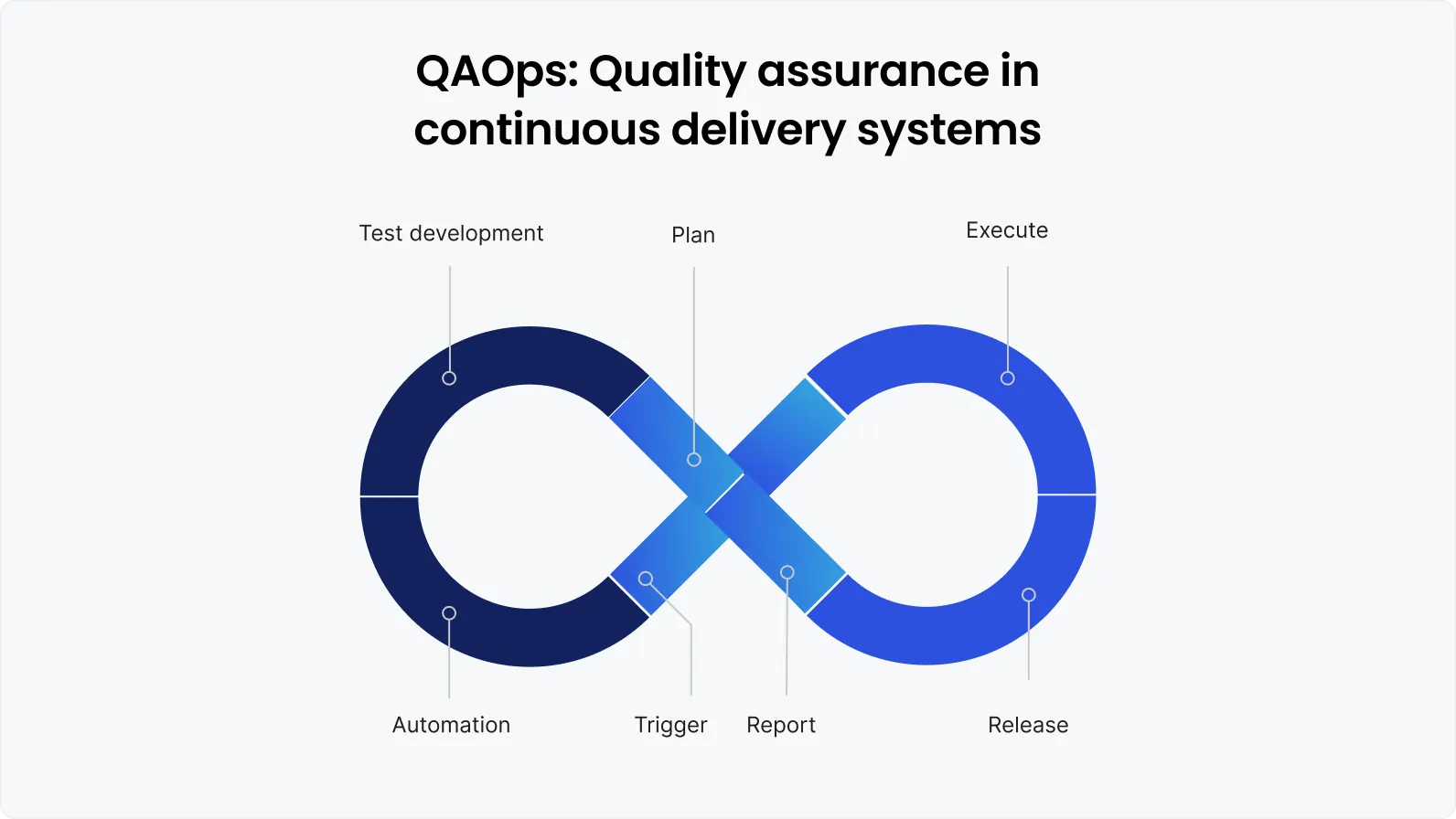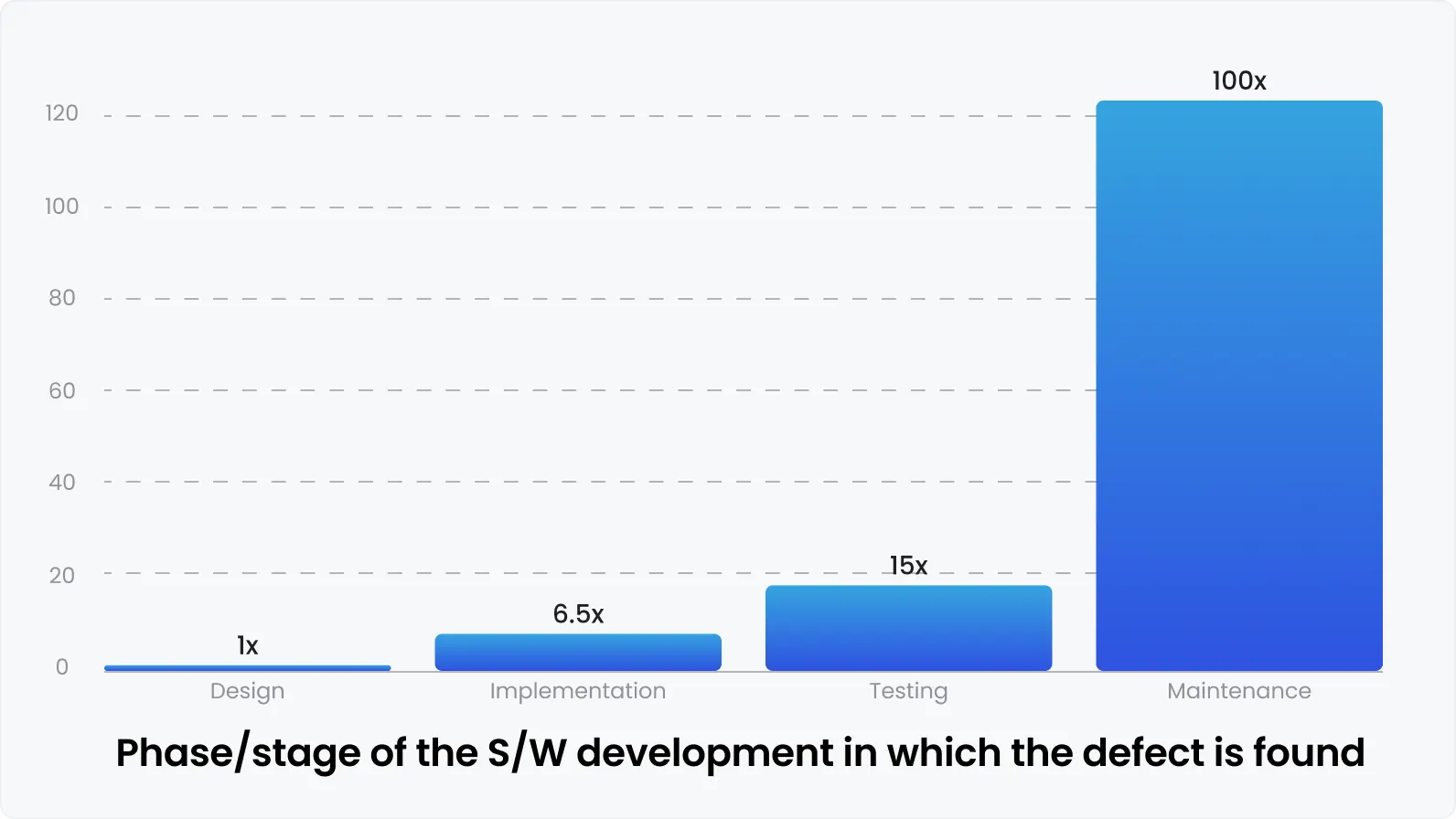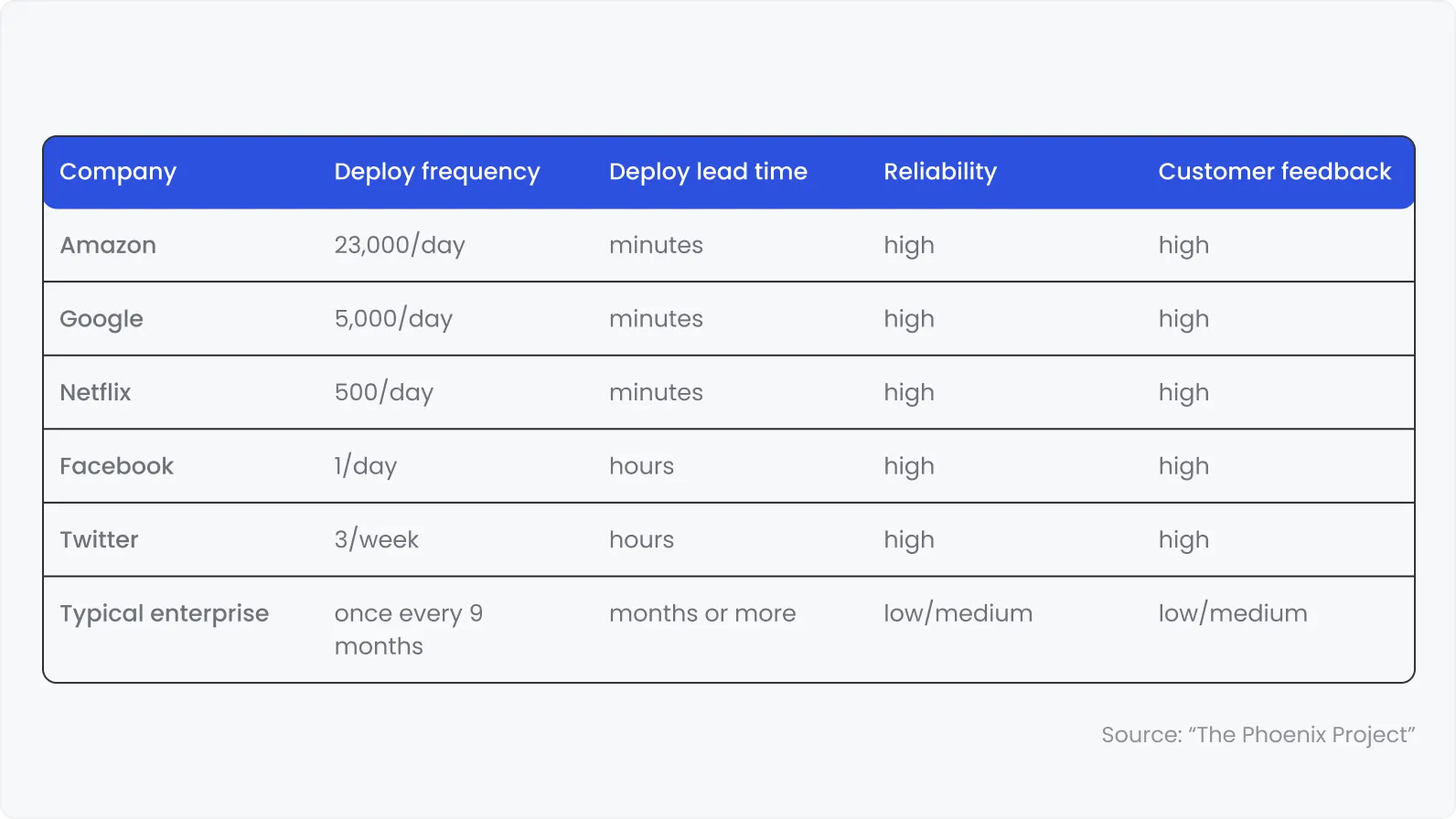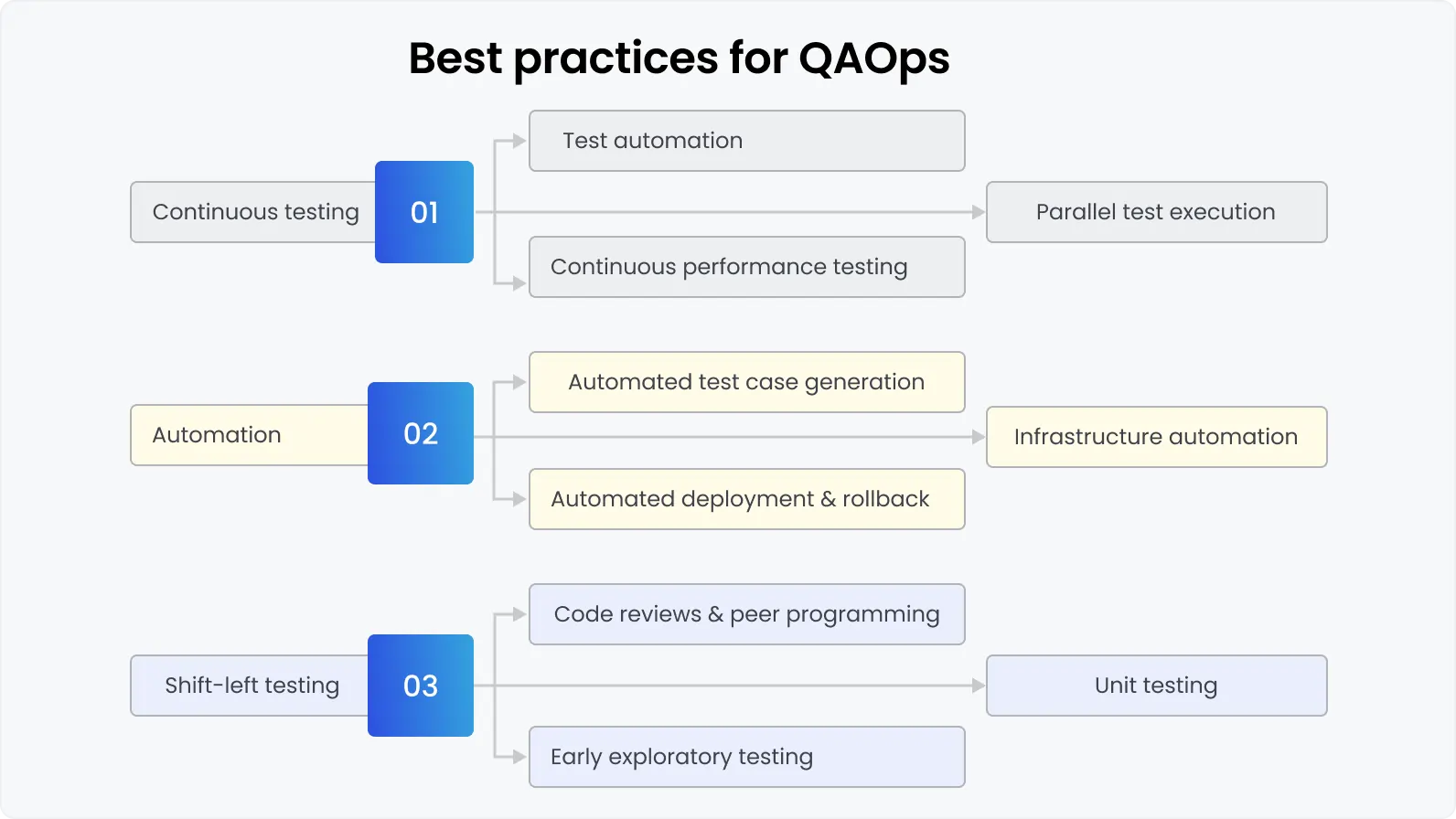Companies with a well-planned quality assurance operations strategy report about 50% faster release cycles and 20% fewer defects post-launch. This shows how critical a strategic approach is in modern software development.
Enter QAOps. By seamlessly integrating quality assurance into the development and operations process, QAOps helps teams continuously test, detect, and fix issues before they reach production. Not only by automating tests but rather by embedding quality throughout every step of development. This practice ensures that software delivery remains consistent, reliable, and fast.
Yet, implementing QAOps without a clear plan can lead to chaos rather than efficiency. This is where a structured QAOps roadmap becomes indispensable. It guides teams through each critical phase of QAOps implementation, ensuring that quality assurance practices align with business goals and that performance metrics are tracked to measure success.
Understanding QAOps
What’s QAOps in four paragraphs

QAOps methodology integrates quality checks into the continuous integration (CI), continuous delivery (CD), and continuous testing (CT) pipeline. Traditional QA often occurs as a distinct, end-of-process phase. This, in turn, leads to delayed releases.
QAOps strategy changes the way we think of testing as embedding testing within each development stage ensures defects are caught and resolved before they escalate. In practice, this means that each code commit initiates automated tests, delivering feedback directly to developers in real-time. This continuous testing loop keeps code healthy and drives software quality improvement.
QAOps doesn’t just automate individual tests but manages the entire ecosystem. It integrates with popular tools (Jenkins, CircleCI, or GitLab) to:
Automatically spin up environments
Execute tests across multiple devices or browsers
Immediately highlight any deviations from expected behavior
QAOps facilitates simultaneous unit, integration, and acceptance tests, providing a helicopter view of code quality in staging, production, or development.
Benefits of adopting QAOps
Improved software quality (surprise!): Since testing is at every stage of development, bugs are caught early. Automation tools continuously run tests, ensuring that no defects go unnoticed.
Faster release cycles: QAOps automates testing and integrates quality checks into the CI/CD pipeline. Teams no longer need to wait for separate testing phases, which speeds up the time for new features and updates releases.
Enhanced collaboration: Teamwork thrives in QAOps. Development, QA, and operations teams perform together, continuously receive and provide feedback. They share responsibility for the quality of the product and drive the constant extra mile in terms of workload and innovations.
Setting the foundation
Assessing the current state
Assess the current state of your QA processes, tools, and infrastructure. This helps identify gaps, inefficiencies, and areas for improvement. Without a thorough understanding of the baseline, the QAOps roadmap can become misaligned with technical requirements or business needs. A red flag may be here.

Two effective frameworks for assessment
The Maturity Model Assessment
The Capability Maturity Model Integration evaluates the maturity level of your QA processes across several dimensions, including automation, integration with development pipelines, and team collaboration. It ranks your current setup on a scale:
Initial: Processes are unpredictable and success depends on individual effort.
Managed: Basic project management processes are established.
Defined: Processes are well characterized and understood.
Quantitatively managed: Processes are measured and controlled.
Optimizing: Focus on continuous process improvement and innovation.
Determine the current maturity level of your company through:
Surveys and questionnaires: Use structured assessments to gather data on existing processes.
Interviews and workshops: Engage with stakeholders to understand their perspectives on current practices.
Your next steps:
Gap analysis: Compare current practices against CMMI best practices to pinpoint deficiencies.
Prioritization: Determine which areas require immediate attention based on impact and feasibility.
The capability assessment framework (CAF)
CAF focuses on assessing the capabilities of your QA infrastructure, including toolsets, automation coverage, and technical skills within the team.
It evaluates your ability to scale and manage QAOps practices, looking at things like test environment readiness, cloud compatibility, and integration with DevOps tooling.
Ideal for diversified and relatively small teams, where the existing QA setup may not be equipped enough to handle the complexities of continuous testing.
Stakeholder involvement
Involve key stakeholders early in the planning process to align with business objectives. Stakeholders from diverse departments must be part of the strategy to ensure the roadmap addresses both technical and business requirements.
Five top tips for effective stakeholder involvement
1/ Start with business goals:
Ensure that the conversation begins with business priorities, not technical details. Stakeholders from leadership will engage more when they see how QAOps contributes directly to achieving faster time-to-market, reduced costs, or higher customer satisfaction.
2/ Find a common ground:
Stakeholders from different departments may not get technical jargon and – what is more important – may not share your understanding and opinion. When discussing QAOps, use clear, straightforward language that relates back to business outcomes. Turn the tech speak into KPIs such as reduced downtime, improved customer experience, or faster releases.
3/ Define ownership and accountability:
Each stakeholder must understand their role in the QAOps process. Assign clear responsibilities and set expectations, and you will create a sense of ownership. For example, the product team may be responsible for ensuring quality aligns with user experience goals, while the operations team bears integration into deployment processes.
4/ Can’t meet? At least, pencil them in:
Set up bi-weekly or monthly touchpoints to review progress. Can’t make it to a consistent meeting on time? Pencil meetings in — this will create a little tension on the important task and help align priorities. Use dashboards with real-time metrics on defect rates or release speed — a great boost for data-driven discussions.
5/ Invite feedback early and often:
Stakeholders must feel that their input is valued throughout the process. Create opportunities for feedback at every phase of the roadmap. Whether through meetings, surveys, or feedback loops, early and continuous feedback helps identify issues before they escalate and ensures that all voices are heard.
Key milestones in a QAOps roadmap
Milestone 1: Initial planning and strategy development
Vision and objectives for QAOps
Establishing a clear vision means defining what success looks like for your QAOps initiative. Like reducing time to market, improving software quality, or integrating automated testing. Note that the more specific your vision is, the easier will be the way.
Key stakeholders and their roles
Involving stakeholders is critical for aligning with business objectives. Define each stakeholder's role from the outset, they may be product owners, QA leads, DevOps engineers, etc. Use the tips on stakeholder management we previously mentioned, including assigning clear responsibilities and ensuring ongoing communication.
High-level strategy and timeline
Once the objectives and stakeholders are clear, pencil in a strategy that outlines key steps and timelines for implementation. Obvious, but we should mention: Jira, Trello, and Monday.com are excellent for building out a roadmap with detailed milestones. These tools allow for assigning responsibilities and tracking progress. This is not to mention real-time collaboration, visual project management, and easy adjustment as priorities shift.
Milestone 2: Tool selection and infrastructure setup
Tools for automation, testing, and integration
To the tool selection. Evaluate them based on compatibility with your current infrastructure, scalability, and ease of integration with CI/CD pipelines. Chances are you’ll choose popular options, Jenkins for CI/CD, Selenium for automated testing, and Docker for containerizing environments. Good choice, indeed. When configured correctly, they allow for seamless integration between development, testing, and operations.
Necessary infrastructure and environments
And to the tools once again. Infrastructure-as-Code (IaC) tools like Terraform can help automate the provisioning of scalable testing environments in the cloud. This setup ensures that environments are consistent and always available for automated tests, reducing the time spent on manual configuration.
Milestone 3: Team training and skill development
Training and development programs
Even the most advanced tools won’t deliver results if the team isn’t equipped to use them effectively. Invest in training that upskills both the QA and DevOps teams (all teams, ideally). Annual training budgets for teams of 10-20 specialists in the US typically range between USD 15,000 to USD 30,000 or 1% to 5% of the average annual salary of the team. This covers certifications for tools like Selenium, Jenkins, and Docker, as well as courses on CI/CD practices and test automation strategies.
Ensure proficiency in tools and methodologies
Beyond basic tool proficiency, ensure that team members understand how to apply these tools within the QAOps framework. This includes training on automated test writing, continuous testing methodologies, and managing infrastructure in cloud environments. Internal workshops, online courses, and mentorship from senior engineers can help bridge any gaps in expertise.
Milestone 4: Pilot testing and initial rollout
Pilot tests to validate QAOps processes
Before going all in with QAOps practices across the company, run pilot tests on a small project just to validate the new processes, tools, and workflows without major disruptions. But select wisely: base your choice on projects’ manageability, so issues can be identified and resolved early in the process.
Start slowly and gather feedback from developers, QA engineers, and operations teams. Use it to make necessary adjustments to the testing environments, automation tools, or workflows.
Milestone 5: Full implementation and scaling
Expand QAOps practices to all projects
Once the pilot project is successful, you can scale QAOps practices across all teams and projects — fully integrating continuous testing, automated pipelines, and cross-functional collaboration. Ensure that each team is using the same tools and methodologies to maintain consistency and efficiency.
Monitor and optimize processes
Remember that QAOps is not static. Be aware of key metrics (defect rates, test coverage, deployment frequency, etc.) since it is critical for matching results with the expected results. Regular feedback and performance metrics must be analyzed to make ongoing improvements and adjustments to both the tools and the workflows.
Essential metrics to track
Every endeavor goes hand in hand with analytics. Otherwise, you will just lose your bearings in the endless pond of effort. But what metrics to track? The ones that measure progress, identify bottlenecks and ensure that quality assurance efforts align with business goals. Below are the eight of the key QAOps metrics.
1. Automation coverage
What it measures: Number of automated tests compared to manual tests. This automation metric is often expressed as a percentage.
Why it matters: High automation coverage reduces human error, speeds up testing, and increases consistency. A solid benchmark is a 70-80% automation coverage rate.
How to track: Try the mentioned TestComplete or Selenium testing to monitor the total number of test cases covered.
2. Deployment frequency
What it measures: The number of times code is deployed to production within a given timeframe (e.g., daily, weekly).
Why it matters: Higher deployment frequency is a sign of a healthy CI/CD pipeline and rapid, reliable releases. Fun fact: Amazon deploys about 50M times per year.
How to track: Jenkins and GitLab CI provide data on how often code is pushed to production.

3. Defect detection rate
What it measures: During testing bugs vs. post-release bugs ratio.
Why it matters: If you find bugs earlier, the product is better, an obvious fact. Strive for a 95+% defect detection rate before deployment.
How to track: Bugzilla can track defect detection rates across different stages of development.
4. Cycle time
What it measures: The time it takes to go from a code commit to a release in production.
Why it matters: Shorter cycle times indicate that teams can move code from development to production quickly and with fewer bottlenecks. Reducing cycle time is a key goal of QAOps, often aiming for under 24 hours for code-to-release.
How to track: CircleCI and Azure DevOps offer insights into how long it takes from code commit to release.
5. Mean time to recovery (MTTR)
What it measures: When your product fails, it needs some time to come back to life. This time is MTTR.
Why it matters: DevOps and QA integration aim to minimize MTTR through continuous monitoring and preparing teams to quickly respond to failures. A good yardstick for MTTR is under 60 minutes for critical systems.
How to track: PagerDuty and New Relic are here to help.
6. Test execution time
What it measures: The total time taken to execute all automated tests.
Why it matters: Optimizing test execution time is critical for maintaining fast release cycles without sacrificing quality. Long test execution times can bottleneck the CI/CD pipeline. For effective QAOps, the test execution time is under 1 hour for large-scale systems.
How to track: Use Katalon or Selenium Grid to monitor and optimize this metric.
7. Customer satisfaction
What it measures: Customer feedback and satisfaction scores (e.g., Net Promoter Score - NPS) post-release.
Why it matters: Ultimately, the success of QAOps practices is reflected in the end-user experience. Like in any business, overall success (and, consequently, profit volume) is measured by customers' willingness to choose your product among other alternatives over and over again.
How to track: Consider using Zendesk or SurveyMonkey. This software captures and analyzes customer feedback, provides insights into how well your QAOps strategy performs and drives user satisfaction.
8. Release stability
What it measures: The percentage of releases that are successful without requiring immediate rollbacks or hotfixes.
Why it matters: Release stability is an indicator of both the effectiveness of the QAOps process and the reliability of the codebase. A higher percentage of stable releases means fewer issues in production and a more streamlined deployment process.
How to track: Use GitLab or Jenkins to track successful vs. failed deployments and monitor rollback frequency.
Best practices for QAOps roadmap execution
QAOps roadmap should have clear steps. However, it demands an adaptable approach that has space for pivot, yet simultaneously aligns with business goals. Let’s run through the best practices for smooth QAOps implementation.

Iterative approach
Why it matters: QAOps isn’t a one-time project, you sign the obligation to improve the process continuously. And an iterative approach will allow you to constantly evolve based on real-time feedback and performance data. Implementing QAOps in small, manageable phases ensures that adjustments can be made without derailing the entire pipeline.
How to apply: Begin with a pilot project to validate the smoothness of the QAOps implementation. Insights, gathered during the pilot, will help you to refine and scale the process across larger projects. Regularly revisit the roadmap to align with new business priorities and emerging technologies.
Collaboration between teams
Why it matters: The success of QAOps hinges on the seamless collaboration between development, QA, and operations. Breaking down silos is key to integrating quality assurance at every step of the development pipeline.
How to apply: Implement cross-functional teams where QA, dev, and ops collaborate from the planning stages through deployment. Use real-time communication tools like Slack and project management platforms like Jira to foster continuous dialogue and ensure accountability across all teams.
Regular reviews of the roadmap
Why it matters: QAOps requires constant monitoring and adjustment to ensure alignment with business goals. Regular reviews ensure the roadmap remains relevant and the metrics track meaningful progress.
How to apply: Schedule quarterly or bimonthly reviews to evaluate key metrics such as defect detection rates, deployment frequency, and customer satisfaction. Use these reviews to identify bottlenecks or areas for optimization and adjust the roadmap accordingly.
Documentation of processes and metrics
Why it matters: Detailed documentation matters. It’s the best investment in transparency, traceability, and knowledge-sharing across teams. With development, documented processes make it easier for new team members to break into the flow without breaking down the entire process.
How to apply: Hire the tech writer. Seriously. Or teach your QA specialists and developers to create clear and comprehensive documentation (with processes, environments, metrics, etc.) in Confluence or Notion. Ensure documentation is regularly updated.
Continuous integration of feedback loops
Why it matters: Continuous feedback from both automated testing and user input allows you to deal with issues faster and improve drastically.
How to apply: Selenium and Grafana provide automated feedback and can track test results and performance metrics in real time. Collect feedback from end users (for this reason: Zendesk or SurveyMonkey) and integrate that input into the roadmap for future releases.
Scalability planning from the start
Why it matters: As projects grow, so do the demands on the QAOps process. Planning for scalability ensures that QAOps can handle increasing code volumes, environments, and testing requirements without performance issues.
How to apply: Use container orchestration tools like Kubernetes to scale test environments dynamically. Leverage cloud platforms (AWS, Google Cloud) for on-demand test infrastructure, ensuring that QAOps can easily expand as your business scales.
Security integration from day one
Why it matters: QAOps is incomplete without integrated security testing. Adding security to the QAOps process early prevents vulnerabilities from slipping through the cracks.
How to apply: Implement DevSecOps practices, integrating security tools like Snyk and OWASP ZAP into your CI/CD pipeline. Conduct regular security audits and make security testing a core part of the continuous testing process.
To sum up
Building a successful QAOps roadmap is not a one-off solution. Planning, stakeholder alignment, tool selection, infrastructure setup, team training, pilot, and full implementation — each step is crucial and implies continuous improvement.
Keep an eye on automation coverage, deployment frequency, and defect detection rates — these metrics allow teams to measure progress and ensure further development.
A well-executed QAOps strategy has untalkable benefits, like faster releases, improved software quality, and enhanced collaboration between teams. The key is the iterative approach. It ensures that businesses can stay agile, meet user demands, and optimize their development and testing processes over time.
Contact us now to book a free 1-hour QA consultation on how our QA and testing services can help you.
